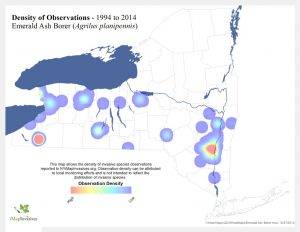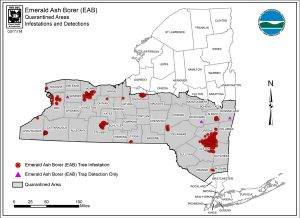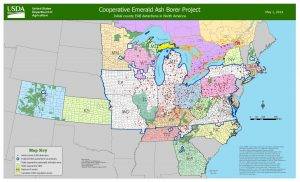The Emerald Ash Borer, Agrilus planipennis Fairmaire (Coleoptera: Buprestidae), commonly referred to as “EAB”, is an invasive wood-boring beetle. Native to Asia, the beetle’s first North American populations were confirmed in the summer of 2002 in southeast Michigan and in Windsor, Ontario. EAB was likely introduced to the area in the mid-1990’s in ash wood used for shipping pallets and packing materials in cargo ships or shipping containers. Emerald ash borers feed on and eventually kill all native ash trees (Fraxinus spp.). Slowing their spread is imperative.
The Emerald Ash Borer (EAB) is a member of a family of insects called metallic wood-boring beetles (Buprestidae). Adult EAB are a brilliant metallic green color. The dorsal side of the abdomen, which can be seen when the wings are spread, is a metallic purplish-red. Adult EAB average 3/8 inch to 3/4 inch (10 mm to 20 mm) long and 1/6 inch (4 mm) wide (males are slightly smaller than females).
Biology and Life Cycle
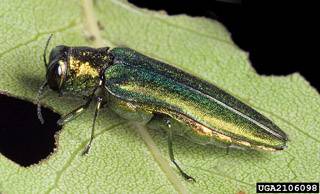
EAB generally have a one-year life cycle, emerging from beneath the bark of ash trees beginning in late-May or early-June with peak activity between mid-June and early-July. They emerge between 450 and 500 growing degree days which coincides with the flowering of black locust, Robina pseudoacacia. Track growing degree days at known EAB infestation locations at the Northeast Regional Climate Center website.
Northeast Regional Climate Center
EAB adult flight season is finished by early August. Adult EAB are most active during the day and favor sunny, warm weather; sheltering in bark crevices or under foliage when it is rainy, windy or cooler. The life span of adult EAB is about 3 weeks.
Adult EAB feed along the margins of leaves, leaving small, irregular shaped edges. Newly emerged adults must feed for at least several days before mating; mated females feed for an additional 1 to 2 weeks before laying eggs (females can mate multiple times; males do not). An “average” female may lay from 60 to 100 eggs during her lifespan, placing the eggs singly in bark crevices or under bark flaps on the trunk or branches (some long-lived females may lay more than 200 eggs).
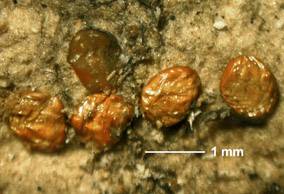
Eggs hatch in 7 to 10 days. The slightly flattened, white to cream-colored larvae have 10 abdominal segments with the last 3 or four segments resembling bells that are nested one upon the other. This is a good characteristic to use when comparing EAB to other insect larvae that may be found under the bark of ash trees.EAB larvae go through five life stages (instars) with mature larvae reaching an average length of 1 1/2 inches (38 mm). After hatching, the first instar larvae chew through the outer bark and feed in the phloem (the inner bark, the pipeline through which food is passed from the leaves to the rest of the tree) and the cambium (the growing part of the trunk, located between the phloem and the sapwood).
As they feed the larvae wind back and forth, either up or down the stem, creating serpentine (S-shaped) “galleries”, characteristic of this wood-boring beetle. The galleries are filled with “frass”, a fine sawdust-like material. When EAB have finished feeding, the final galleries can extend from 4 inches to 20 inches (10 to 50 cm) in length.
(To distinguish EAB galleries in Ash from galleries of other insects, please see the document “Recognizing Insect Galleries in Ash Trees in Minnesota.”)
Recognizing Insect Galleries in Ash Trees in Minnesota
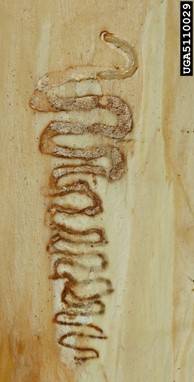
Larval feeding ends in autumn, at which time the fifth instar larvae excavate pupal chambers 1/2 inch beneath the surface of the sapwood and overwinter as pre-pupae. Pupal chambers can also be found
in the outer bark when it is thick enough. Pupation generally takes place the following spring (late-April to May), with adults staying in the pupal chambers for 1 to 2 weeks, at which time they emerge headfirst through a distinctive 1/8 inch to 1/6 inch (3 mm to 4 mm) D-shaped exit hole, beginning the cycle of life over again. The presence of the exit holes typically goes undetected until trees show other, more visible symptoms of being infested.
It should be noted that when EAB is developing in healthy, newly infested ash trees larvae may need an additional year (a 2-year life cycle) before pupating and emerging as adults. As infestations develop and EAB populations increase, the 1-year life cycle becomes the norm.
Online EAB Pesticide Recertification Class
Courses are available through Cornell’s Pest Management Education Program (PMEP).
Detection and Management of the Emerald Ash Borer: Natural History, Detection and Community Action Plan. Now available as an online Pesticide Recertification Class.
The course reviews the Identification and Natural History of EAB and what your community can do to prepare for this pending pest. Learn the basics of EAB and gain Pesticide Management Education Program recertification credits in categories 2, 3a, 9, 10, 6a, 1a and 25.
Maps
Click to enlarge.
